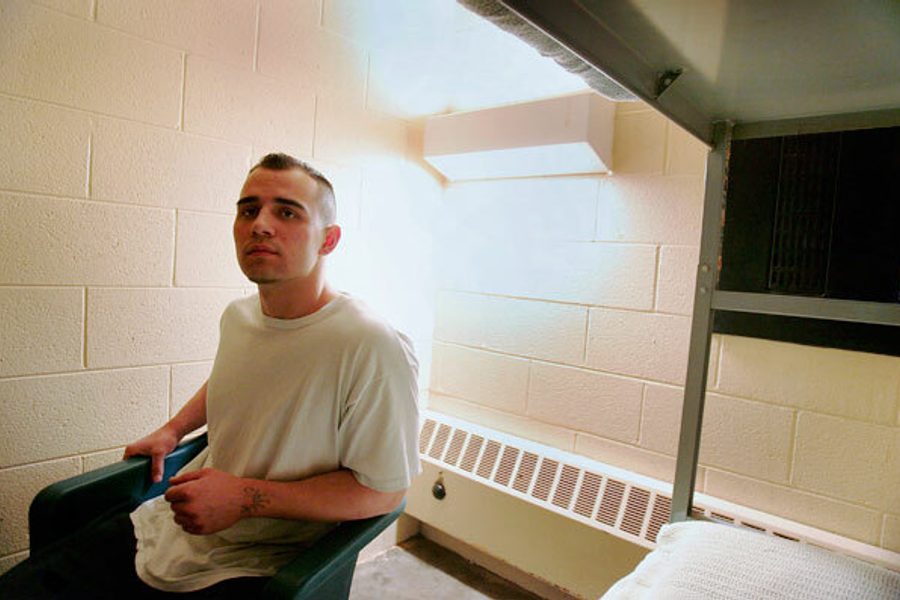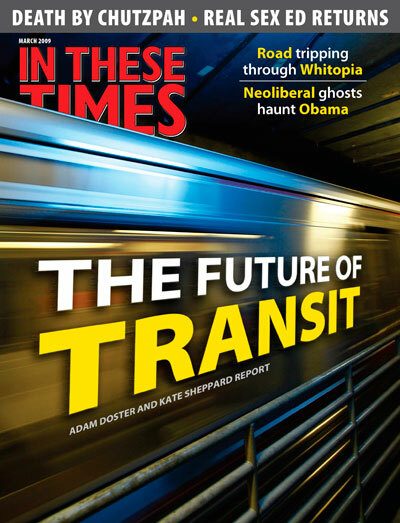Ending the War on Drugs
Will the Obama administration put justice back in the criminal justice system?
Silja J.A. Talvi

President Obama faces a heap of crises: a major economic recession, crumbling national infrastructure, and ongoing wars in Iraq and Afghanistan.
Buried in that heap is another war, one less present in public discourse but no less toxic: the drug war. The concentrated battleground of the drug war has been on domestic soil, with America’s so-called interdiction efforts spreading the fight across the world, from poppy-rich Afghanistan to the coca-nurturing Andes to the most brutal battlefield of them all, Mexico, which saw more than 5,600 drug-related murders last year, including several that involved publicly displayed decapitations
With the Obama administration, many see an unprecedented opportunity for meaningful criminal justice/drug war reform. Much of that hope stems from Obama’s seven-year track record as a state senator in Illinois – a state with one of the nation’s largest prison populations. In Springfield, Obama sponsored more than 100 bills on crime, corrections, treatment, re-entry, racial disparities and the death penalty that were mostly (though not exclusively) progressive in nature.
He also gained respect among younger voters for his willingness to talk candidly about his teenage drug use, and his present-day battle with nicotine addiction. During a campaign stop at Northwestern University while running for the U.S. Senate in 2004, Obama told a crowd of students that he supported decriminalizing marijuana (a position he no longer supports publicly). More significantly, Obama flatly stated that “the war on drugs has been an utter failure.”
“Most of what Obama has said previously on criminal justice issues has been good,” says David Borden, director of the Drug Reform Coordination Network in Washington, D.C. “If he carries some of that into office, we could see an enormous change in the direction of the drug war and sentencing policies. That said, criminal justice reform, especially when it comes to drugs, has always been the first issue the Democrats drop when it looks like they’re being called ‘soft on crime.’ “
Marc Mauer, director of the Sentencing Project in Washington, D.C., agrees with this cautious optimism.
“The political climate on crime issues has shifted significantly over the last 10 years or so,” says Mauer. “At the national level, there’s a modest but growing bipartisan movement for more rational policies. We see it most clearly around prison re-entry issues.”
After years of operating on the margins of political discourse, drug war and criminal justice reform movements have reached a new plateau of recognition and respect. Conservative lawmakers, law enforcement associations, health professionals and religious groups have joined the call for fiscal, legislative and social changes in our approach toward criminality. Even mainstream civil rights groups, which often shied away from directly addressing the injustices of the drug war and the class and ethnic disparities in arrest and sentencing rates, have grown more comfortable allying themselves with criminal justice reform.
Yet mainstream Democrats have continued dragging their feet – to the point of pushing the kind of punitive legislation championed by President Reagan.
“We’ve seen this for over 30 years now, that Democrats have often been reluctant or even hostile to the idea of embracing criminal justice reform,” Mauer says. “Our strategy is to continue to reach out to Republicans and conservative constituencies to develop broad support for some of these reforms. We need to give Democrats a comfort zone … a sense that they’re not being ‘too out there.’ “
The Second Chance Act, signed into law in April 2008, provided just such a comfort zone for Congressional Democrats and Republicans alike. Introduced by Rep. Danny Davis (D-Ill.) and Rep. Chris Cannon (R-Utah) in the House and by Sens. Joseph Biden (D-Del.), Arlen Specter (R-Pa.), Sam Brownback (R-Kan.), and Patrick Leahy (D-Vt.) in the Senate, the act was signed into law in April 2008. It was a remarkable step forward for a country that had all but turned a blind eye to sky-high recidivism rates for decades on end. (Of nearly 752,000 people released from U.S. prisons annually, two-thirds will be re-arrested within three years.)
The Second Chance Act provided an initial $362 million in federal grants to government agencies, as well as community and faith-based organizations, for the purpose of providing employment assistance, substance abuse treatment, housing, family programming, mentoring, and other social services known to reduce re-offending and drug addiction relapse. Unfortunately, the Democratic-controlled Congress has yet to authorize that funding.
States take the lead
In the meantime, state legislatures aren’t waiting for the federal government to provide cues on how to handle criminal justice reform. Mauer points out that many states have already enacted their own changes. Connecticut, Iowa, Oregon and Wisconsin have specifically enacted legislation to address racial disparities in arrest and sentencing rates – and to ensure that proposed legislation be reviewed for its potential to exacerbate such disparities. (Obama and Biden have also placed racial profiling, as well as a federal version of racial impact legislation, on their national agenda.)
Since 2004, at least two dozen states have enacted policies or legislation that promote alternative sentencing and treatment diversion; diminish the number of parolees sent back to prison for non-serious violations; implement gender-responsive strategies to address the unique needs of females in the criminal justice system; and/or modify mandatory minimum sentencing laws.
And in 2006, the U.S. Conference of Mayors even passed a resolution opposing all mandatory minimum sentences for drug crimes and called for “fair and effective” sentencing policies.
Legislators and politicians have begun to realize that these kinds of reforms are much more likely to garner public support than ever before – even in red states like Kansas, where an early-release program has been created for prisoners who complete education, counseling or other programming requirements.
With one in 31 Americans now under some form of correctional supervision, mass incarceration is hitting closer to home for urban, suburban and rural residents who never envisioned family members would one day be locked away in remote prisons. Some have even been shipped off to other states. (Out-of-state transfers are routine in the federal system, and increasingly common in overcrowded state prison systems that contract with private prison operators.)
While California, New York and Texas have begun to show slight decreases in their bloated prison populations, the South has become the epicenter of the latest incarceration upsurge: Kentucky (#1), Florida (#5), Virginia (#6), Alabama (#7), and Louisiana (#8) are in the nation’s top 10 for imprisonment rate increases from 2000 to 2007. Drug-related arrests – nearly 2 million in 2007 – continue to play a major role in driving up the numbers of jail and state prison inmates, while the majority of federal prisoners are doing time for drug offenses (more than 95,000 men and women in 2007).
The human cost of mass incarceration is increasingly visible, and so, too, are the economic costs. According to the Pew Center on the States, total state general fund expenditures on corrections rose 315 percent from 1987 to 2007, while 13 states devote more than $1 billion per year out of general funds to their corrections departments. (At nearly $9 billion, California’s annual spending on corrections leads the nation.)
By 2011, the Pew Center’s Public Safety Performance Project predicts that the nation’s prison population will grow by more than 190,000 men and women, at a cost of $27.5 billion, while immigration-related detention is likely to increase at an exponential rate. Already, the U.S. government detains more than 400,000 immigrants at some point during the year, usually within the confines of privately run facilities.
Overall, the progressive think tank Justice Policy Institute estimates that total annual spending on all facets of the criminal justice system – including policing, imprisonment and the judiciary – adds up to a staggering $213 billion.
Reframing the debate
Officially, the government is waging the drug war to combat illicit drugs. Instead, it has turned into a war against the poor en masse, says Drug Policy Alliance Director Ethan Nadelmann. People of color, who are disproportionately poor, make up 35 percent of the national population, and yet comprise 69 percent of the national prison population.
Jack Cole, a former narcotics agent and founder of Law Enforcement Against Prohibition (LEAP), says that the frequency of undercover and outdoor buy-bust drug operations in inner-city neighborhoods may make for great arrest numbers, but they do almost nothing to put a dent in illicit drug sales – or use – because they target the poorest and lowest-level drug users and sellers.
LEAP – whose members are current and former police officers and police chiefs, federal agents, undercover operatives and prison wardens – is the first U.S. law enforcement organization to advocate for the full legalization of all drugs. It recently co-commissioned a study by Harvard University economics professor Jeffrey Miron, who studied the cost-benefit of legalizing and taxing drugs in the same manner as alcohol and tobacco. According to Miron’s analysis, released in December, tax revenues nationwide would amount to approximately $32.7 billion a year. Miron also found that, if drugs were legalized, the United States would save more than $44 billion annually in costs related to the enforcement of drug laws.
“The repeal of alcohol prohibition had a great deal to do with the fact that we were going through the Great Depression,” says Cole. “Now that we’re in the worst recession since the Great Depression, people are finally thinking about the economy when they think about the drug war. By legalizing drugs, we could go from spending $69 billion on the war on drugs each year to realizing total savings and revenue of $76.8 billion.”
Biden’s record
While LEAP eschews the idea of intermediate steps toward drug policy reform, most other progressive criminal justice organizations and think tanks are reaching for middle ground by appealing to Obama’s sense of fairness and equity.
Vice President Joe Biden should be a strong asset to Obama in this regard, says the DPA’s Nadelmann. The new Congress is likely to take up a bill that Biden sponsored to eliminate the large federal sentencing disparity between crack and powder cocaine use enacted during the Reagan years. (It takes five grams of crack cocaine to trigger an automatic five-year federal prison sentence, whereas it takes 500 grams of powder cocaine to result in the same mandatory minimum.)
Biden has a favorable reputation on criminal justice issues and racial inequities while still remaining a consistent ally to law enforcement, says Nadelmann, which makes him all the more influential with more reluctant members of Congress.
But Biden’s track record is mixed. Early in his career, he was a supporter of punitive, drug war-related legislation. More recently, he touted the RAVE Act – which held club owners and organizers of music gatherings responsible for drug use by participants. When it failed to pass, Biden attached it as a rider to the law enforcement-supported Amber Alert bill (a national alert system to help locate missing children), which Bush signed into law in 2003.
Propaganda machine
Perhaps the biggest obstacle to significant drug policy reform will come from the federal Office of National Drug Control Policy (ONDCP) and its director, the so-called Drug Czar.
John Walters, the Bush administration’s drug czar, continued to put most federal funding dollars into law enforcement and interdiction efforts, blithely touting record-high drug arrest numbers as a sign of progress, even as independent surveys indicate rising levels of substance use and abuse among American teens.
Obama has yet to name a permanent drug czar. (He named Ed Jurith, a long-time ONDCP bureaucrat, its acting director, but Jurith is widely considered a temporary placeholder.) Much of the speculation has centered around former Rep. Jim Ramstad (R-Minn.), a recovering alcohol abuser who favors some treatment options, particularly faith-based and 12-step programs.
But Ramstad also opposes decriminalization, legalization and medical marijuna – to the extent that any debate is out of the question. He also wants to continue the federal ban on needle-exchange funding, a stance Obama does not agree with. Indeed, word of his consideration has brought together a broad coalition of groups in opposition, ranging from Students for a Sensible Drug Policy, to the National Black Police Association, to medical marijuna proponents to HIV/AIDS prevention groups.
Because of the influence of the drug czar on federal policies, LEAP’s Cole says that it is unlikely that Obama will have the political will or backing to recognize that “prohibition has always failed.”
“Every two weeks, for the last 20 years, the U.S. has built the equivalent of 900 prison beds,” he says. “Still, our prisons are bursting at the seams. Over the last 38 years, we’ve had a cumulative arrest record of 39 million arrests for nonviolent drug offenses. When are we going to say, ‘Enough!’?”
The big question is how much concern the Obama administration will ultimately show for people ensnared in the criminal justice system. And what of the plight of prisoners, who collectively constitute the nation’s most vulnerable, least-educated, sickest, poorest, mentally ill and socially castigated individuals?
Reformers say they hope the new administration and Congress will take a cue from the U.S. Sentencing Commission, which is examining ways to alleviate massive national jail and prison overcrowding through sentencing alternatives, drug treatment and support for increased judicial discretion. The commission plans to make its recommendations in May.
During the June 28, 2007, Democratic debate, Obama stood his ground on the need for ongoing criminal justice reform by emphasizing that the system “is not color blind. It does not work for all people equally.”
It remains to be seen how far Obama’s vision for reform will extend and whether it will shine toward the darkest corners of prison cells, far out of sight and therefore all too easily out of mind.
SPECIAL DEAL: Subscribe to our award-winning print magazine, a publication Bernie Sanders calls "unapologetically on the side of social and economic justice," for just $1 an issue! That means you'll get 10 issues a year for $9.95.







